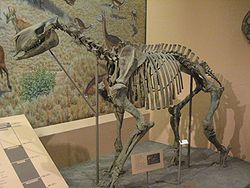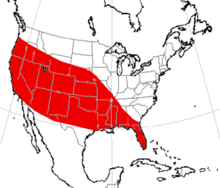- Moropus
-
Moropus
Temporal range: Early Miocene
Moropus elatus skeleton at the
National Museum of Natural History,
Washington, DCScientific classification Kingdom: Animalia Phylum: Chordata Class: Mammalia Order: Perissodactyla Suborder: †Ancylopoda Superfamily: †Chalicotherioidea Family: †Chalicotheriidae Subfamily: †Schizotheriinae Genus: †Moropus
Marsh, 1877Species - M. distans Marsh 1877
- M. elatus Marsh 1877
- M. hollandi Peterson 1907
- M. matthewi Holland and Peterson 1913
- M. merriami Peterson 1914
- M. oregonensis Leidy 1873
- M. senex Marsh 1877

Range of Moropus based on fossil distribution Moropus (meaning "slow foot") is an extinct genus of mammal, belonging to a group called chalicotheres, which were perissodactyl ("odd-toed") mammals, endemic to North America during the Miocene from ~23.0—13.6 Mya, existing for approximately 9.4 million years.
Moropus is related to the modern horse, rhino, and tapir.[1]
Contents
Taxonomy
Moropus was named by Marsh (1877). Its type is Moropus distans. It was synonymized subjectively with Macrotherium by Osborn (1893). It was assigned to Moropodidae by Marsh (1877); to Chalicotheriidae by Marsh (1877), Peterson (1907), Skinner (1968), Coombs (1978), Carroll (1988), Coombs (1998) and Holbrook (1999); and to Schizotheriinae by Geraads et al. (2007).[2][3]
Morphology
Like other chalicotheres, they differed from their modern relatives in having large claws, rather than hooves, on the front feet; these claws may have been used for defense or digging for food.[1] Moropus stood about 8 feet (2.4 m) tall at the shoulder. The three highly compressed claw-like hooves on each foot were split down the middle. These claws actually gave Moropus its name: " slow "or "sloth foot". This name implies that because of the claws, Moropus was a clumsy mover. But the articulation of the phalangeal (finger) bones, in addition to probable large foot and toe pads, shows that Moropus probably could raise the claws slightly to enable it to move about quite smoothly. Because the hooves curve inward, it probably had a pigeon-toed gait.
Body mass
Two specimens were examined by M. Mendoza, C. M. Janis, and P. Palmqvist for body mass.[4]
- Specimen 1: 95.5 kg (210 lb)
- Specimen 2: 134.2 kg (300 lb)
Fossil distribution
- Phillips Ranch, Kern County, California estimated age: ~18.7 Mya.
- Stewart Spring(UCMP 2027), Mineral County and Esmeralda County, Nevada estimated age: ~18.7 Mya.
- Stage Hill I, aka Millennium's End Quarry, Scotts Bluff County, Nebraska estimated age: ~21.6—21.5 Mya.
- Sucker Creek site, Sucker Creak Formation, Malheur County, Oregon ~16.4 Mya.
Species
M. elatus
M. elatus was named by Marsh (1877).
Body mass
Two specimens were examined by M. Mendoza, C. M. Janis, and P. Palmqvist for body mass.[5]
- Specimen 1: 118.4 kg (260 lb)
- Specimen 2: 296.8 kg (650 lb)
Fossil distribution
- Granby site, Grand County, Colorado ~23 Mya.
- Agate Springs Quarries, Sioux County, Nebraska, estimated age: ~20.9—20.8 Mya.
- American Museum-Cook Quarry, Sioux County, Nebraska, estimated age: ~23.03—5.33 Mya.
- Cart Trail Quarry, Box Butte County, Nebraska, estimated age: ~23.0—20.3 Mya.
- Morava Ranch Quarry, Box Butte County, Nebraska, estimated age: ~21.6 Mya.
M. hollandi
M. hollandi was named by Peterson (1907).[6]
Fossil distribution
- Chugwater (aka Chugwater Water Hole), Platte County, Wyoming, estimated age: ~20.7 Mya.
- Jay Em, Goshen County, Wyoming, estimated age: ~20.7 Mya.
- Niobrara Canyon, Sioux County, Nebraska, estimated age: ~20.7 Mya.
M. matthewi
M. matthewi was named by Holland and Peterson, 1913-1914.
M. merriami
M. merrami was named by Holland and Peterson (1914). It was recombined as Macrotherium merriami by Matthew (1929) and Stirton (1939); it was recombined as Chalicotherium merriami by von Koenigswald (1932).
Fossil distribution
- High Rock Canyon, Humboldt County, Nevada, estimated age: ~17.2 Mya.
- Virgin Valley, Humboldt County, Nevada, estimated age: ~16.3 Mya.
- Humbug Quarry, Sioux County, Nebraska, ~16.5—16.25 Mya.
- Echo Quarry, Sioux County, Nebraska, ~16.3—13.6 Mya.
M. oregonensis
M. oregonsis was named by Leidy 1873. It was named by Leidy (1873) and recombined as Moropus oregonensis by Holland and Peterson (1914) and M. C. Coombs in 1978 and 1998, and also by M. C. Coombs, R. M. Hunt, E. Stepleton, L. B. Albright, III, and T. J. Fremd.[7]
Body mass
Two specimens were examined by M. Mendoza, C. M. Janis, and P. Palmqvist for body mass.[8]
- Specimen 1: 58.4 kg (130 lb)
- Specimen 2: 90.3 kg (200 lb)
Fossil distribution
- Johnson Canyon, John Day Formation, Wheeler County, Oregon, estimated age: ~22.2—21.9 Mya.
- Rose Creek, John Day Formation, Wheeler County, Oregon
- Toledo Bend, Fleming Formation, Newton County, Texas, estimated age: 21.9 Mya.
- St. Marks River, Leon County, Florida, estimated age: ~23.1—21.9 Ma.
- Buda Mine site, Alachua County, Florida, estimated age: ~23.1—23 Ma.
M. senex
M. sexex was named by Marsh (1877). It was considered a nomen dubium by Coombs (1978) and Coombs (1998).
See also
References
- ^ a b Palmer, D., ed (1999). The Marshall Illustrated Encyclopedia of Dinosaurs and Prehistoric Animals. London: Marshall Editions. p. 261. ISBN 1-84028-152-9.
- ^ O. C. Marsh. 1877. Notice of some new vertebrate fossils. American Journal of Arts and Sciences 14:249-256
- ^ D. Geraads, E. Tsoukala, and N. Spassov. 2007. A skull of Ancylotherium (Chalicotheriidae, Mammalia) from the late Miocene of Thermopigi (Serres, N. Greece) and the relationships of the genus. Journal of Vertebrate Paleontology 27(2):461-466
- ^ M. Mendoza, C. M. Janis, and P. Palmqvist. 2006. Estimating the body mass of extinct ungulates: a study on the use of multiple regression. Journal of Zoology 270(1):90-101
- ^ M. Mendoza, et al.
- ^ O. A. Peterson. 1907. Annals of Carnegie Museum 4(3)
- ^ M. C. Coombs, R. M. Hunt, E. Stepleton, L. B. Albright, III, and T. J. Fremd in 2001. Stratigraphy, chronology, biogeography, and taxonomy of early Miocene small chalicotheres of North America. Journal of Vertebrate Paleontology 21(3):607-620
- ^ M. Mendoza, et al. p. 270(1):90-101
Categories:- Chalicotheres
- Miocene mammals
- Miocene extinctions
- Prehistoric mammals of North America
- Megafauna of North America
- White River Fauna
Wikimedia Foundation. 2010.


